Scotland's Play Ranger Toolkit
This Play Ranger Toolkit has been developed by the Play Ranger charities supported by Go2Play – focused on growing play opportunities for children and harnessing the expertise of the sector.
7. Risk, Health and Safety
Sample Anti-bullying and Harassment policy
(Organisation) regards bullying and harassment as unacceptable. Children have a right to play in an environment which is free from fear and intimidation. Firm action will be taken whenever it occurs: maintaining a strong stance against bullying helps to create a positive, caring and healthy play environment where individuals are respected and feel secure in a way which enhances personal and social development.
Any allegation of bullying made against a member of (organisation) staff will be dealt with via the child protection procedure if it involves inappropriate physical contact with a child and via the line management system otherwise (e.g. verbal harassment or intimidation).
Bullying is defined as deliberately hurtful behaviour that is repeated over a period of time, against which it is difficult for those being bullied to defend themselves. It is important to remember that not all conflicts involve bullying; when children with the same power, numbers and strength fight or argue from time to time, this is not bullying.
Bullying occurs when a person is made to feel unhappy by one or more people.
Play workers need to be aware of the many different ways in which a child can be bullied or harassed:
- Verbal - name-calling, taunting, teasing, gossiping and humiliating.
- Physical - violence: hitting, kicking, pushing, pinching etc.
- Psychological - being spoken to in a demeaning way or being pressured to conform or do things.
- Social - isolation, rude gestures, exclusion from groups.
- Material - having possessions stolen, damaged or extortion taking place.
- Virtual - when the harassment is perpetuated through texting, email or other virtual means
The most common form of bullying is name-calling; the next most common is being physically hurt or threatened. Whilst teasing and name-calling can sometimes be intended - at least initially - to be taken as a joke, staff need to be aware of how quickly and easily such behaviour can escalate and cross over the line into bullying. Such behaviour should always be tackled at an early stage.
A failure to challenge bullying behaviour can lead children to see bullying as a quick and easy solution to getting what they want.
Note: Bullying can have a racist, sexist, religious or homophobic focus and in these cases it is important to tackle openly the issues surrounding the bullying as well as the behaviour itself. This same approach should also be taken in instances where the bullying is focused on disability.
Play workers should aim to raise awareness of (Organisation's) anti-bullying ethos by:
- Opening up discussions: allowing children to talk about their feelings and concerns in a safe environment, and to enable them to share concerns about bullying.
- Helping children to feel comfortable: they are able to tell staff about any concerns they have with regard to bullying.
- Adults leading by example, and always demonstrating basic good manners.
To really help prevent the spread of bullying, there must be support for all children involved in any incident. The needs of the bully and the bullied should always be taken into account; it is often the case that a child who bullies in one situation may be a victim in another. The focus must be to solve the problem rather than necessarily to punish the bully.
Staff response to bullying
- Act firmly - and be seen to act firmly - against bullying whenever it occurs.
- Bullying behaviour must be taken seriously, and action needs to be taken as early as possible.
- Make it clear to both parties that you disapprove of what the bully has done.
- Don't make premature assumptions - listen carefully to all accounts, providing a forum so that all parties can express their point of view.
- Offer support to both parties: the needs and problems of all the children involved are important.
- Avoid blame wherever possible, particularly in the early stages of dealing with the situation as it tends to cause defensiveness and a breakdown in communication. Reassure the victim, and do as much as you can to empower them (the child may prefer that this be done confidentially).
- Encourage the bully to see the victim's point of view, and discuss the impact and consequences of their behaviour.
- Encourage children not to be passive and not to accept bullying behaviour, whether they themselves are being bullied or they see someone else being bullied.
- Share information with other members of staff.
- It is important to reinforce the anti-bullying ethos through discussions,
- Record the details of any serious incidents and the action that was taken.
When Involving parents:
- It is better done constructively rather than as punishment.
- Be careful with the language you use when dealing with sensitive issues: for example, say "it seems your son/daughter and the other child have not been getting on very well lately" rather than "your son/daughter has been bullying the other child".
- An automatic assumption of blame or an accusation is much more likely to make the parent react defensively and make it much harder to reach a solution.
- Confidentiality must be observed when dealing with issues of bullying, as an accusation of harassment can create problems between families and is potentially defamatory. As a general rule, you should avoid naming the bully when discussing the matter with the family of the child who has been bullied.
(Organisation) needs to monitor bullying, and should address it in team meetings. The nature, frequency, and the suitability of actions taken in response to incidents should be discussed. New children need to be informed about the anti-bullying ethos and be made aware of what they can do if they feel that they or someone else is being bullied or harassed.
Risk-Benefit Assessments, Informing Practice
The information here has been sourced from 'Managing Risk in Play Provision: Implementation guide' (2nd edition), published in 2013 by the Play Safety Forum with Play England, Play Wales, Play Scotland and PlayBoard Northern Ireland.
This first form is designed to support a balanced approach to risk management using the process of risk-benefit assessment ( RBA). It is aimed at those involved in providing play opportunities in a range of contexts, including play areas, public parks, green spaces, out-of-school childcare settings, playwork settings, schools and early year's services. It builds on the guidance document.
The publication is free and readily downloadable on the Play Scotland website.
Those using this form should focus on the significant risks that the play provision gives rise to. The Health and Safety Executive ( HSE) defines significant risks as those that go beyond everyday life and that "are capable of creating a real risk to health and safety which any reasonable person would appreciate and would take steps to guard against."
The full web address which contains this document and additional useful guidance when considering your own policies and procedures when reviewing play and risk can be found at :-
In addition Conwy and Wrexham Council developed a Dynamic Risk Benefit Assessment approach - and developed a flow diagram to help organisations and play workers develop an understanding of assessing whilst in dynamic playful situations. The Council have since kindly let other organisations refer to their approach.
This diagram can be found here:-
Conwy & Wrexham Risk Management Framework: Dynamic Risk - Benefit Assessment Cycle
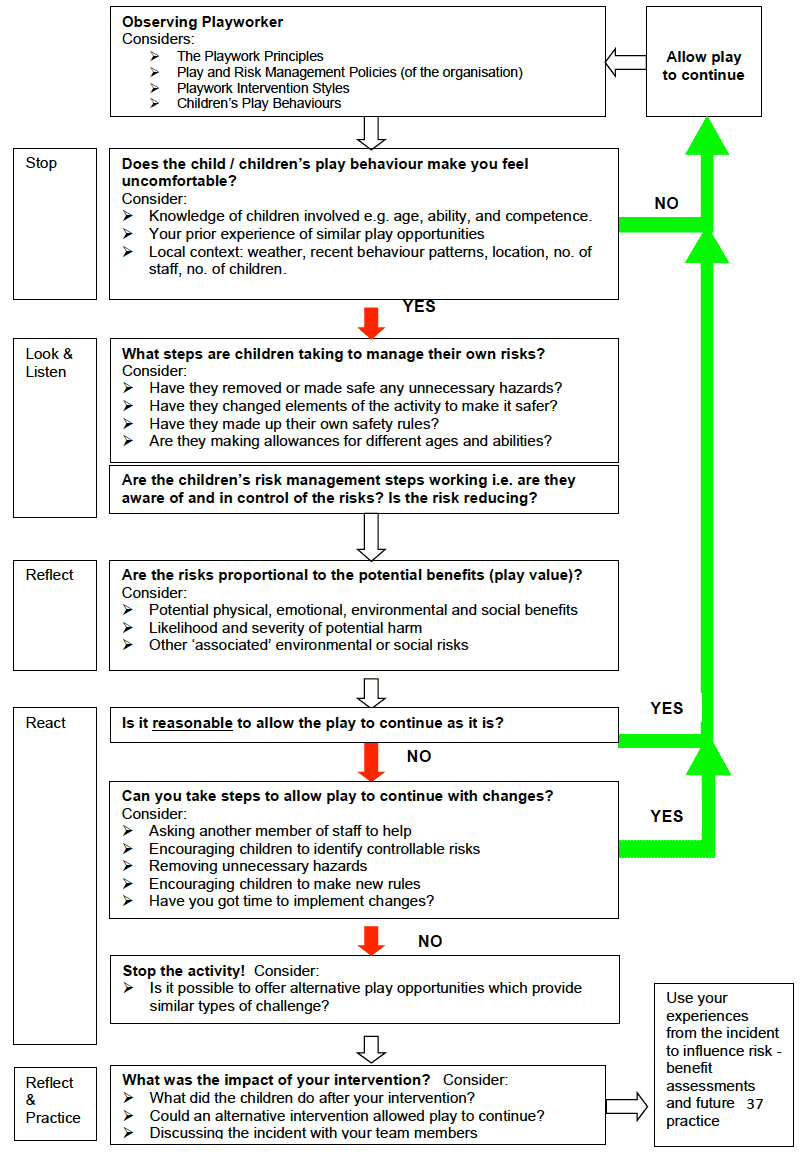
Overview of Risk-Benefit Assessment
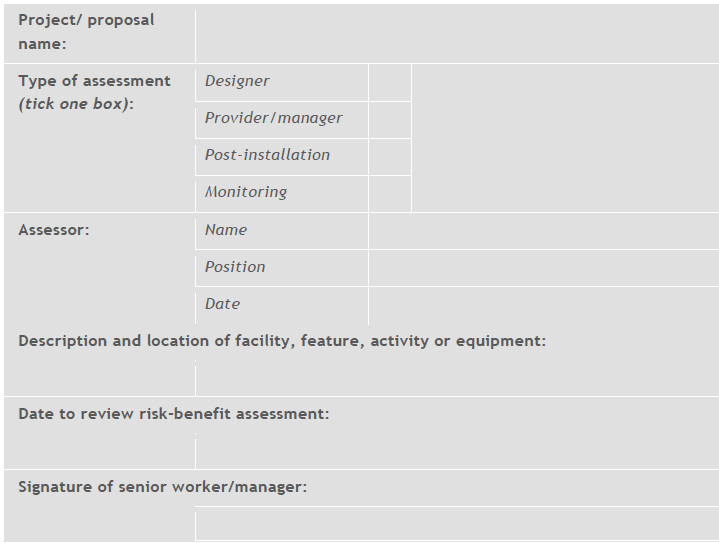
Main Form: Risk-benefit assessment
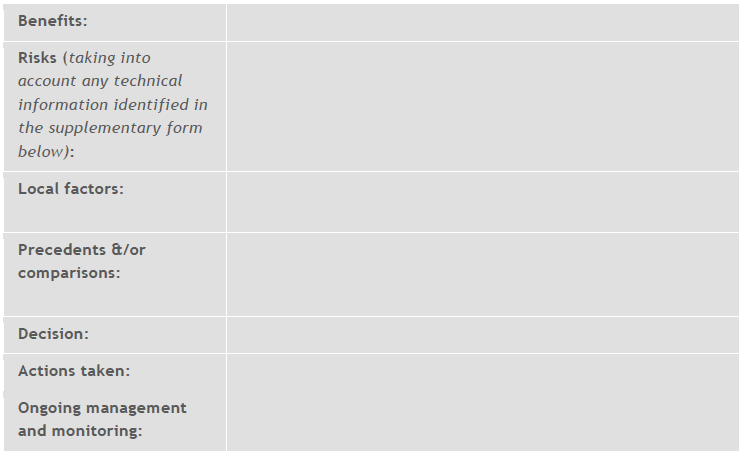
Sample Alternative Play Ranger Risk / Benefit Form
An adaptation of the previous form, however with the same emphasis to assess the risk against the benefit of an activity for a child taking place.
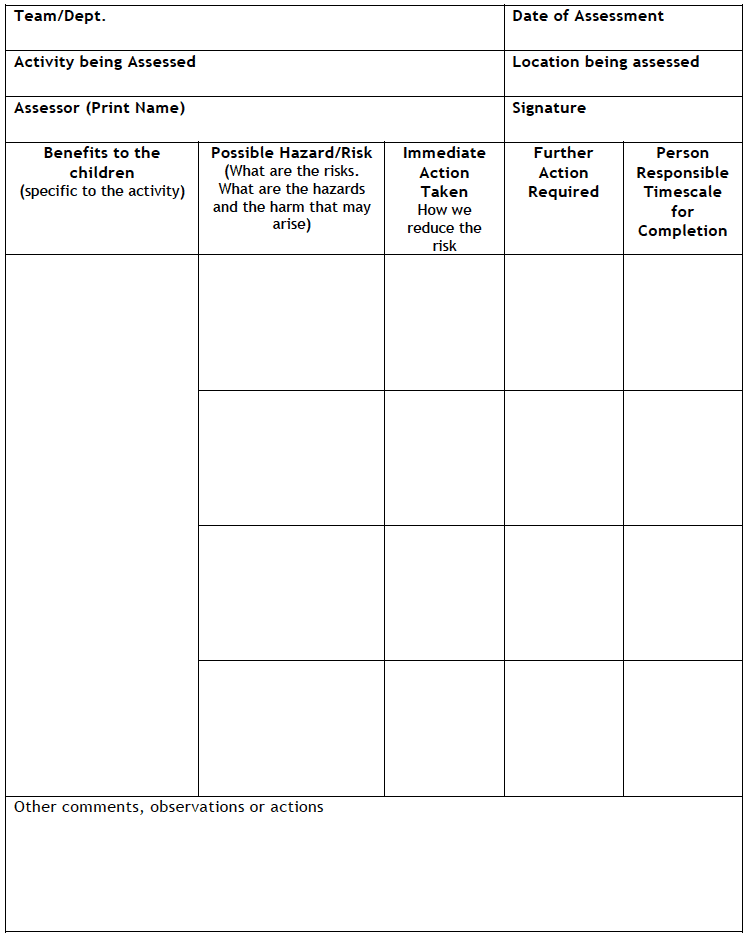
Sample Generic Risk Assessment (Completed)
| Date of assessment: | To be reviewed: | Carried out by: | ||||
| Hazard |
Level of risk 1-4 |
Likelihood 1-4 |
What needs to be done about the hazard? |
What action needs to be done further? |
Action taken by who? |
Result |
| Uneven Ground |
1 |
4 |
Participants are advised about the area before play commences |
Dynamic risk assessments taken through session |
Play Rangers |
C |
| Carrying equipment to and from vehicle |
2 |
1 |
Manual handling training and manual handling policy in Play Ranger Pack. Weight limits for individual items kept to minimum |
Staff asks and observed on safe practice |
Senior Play Ranger |
T |
| Play Equipment Broken/faulty |
2 |
1 |
Play rangers to perform checks before the start of each session. Equipment marked and taken out of use if broken |
Checks to take places during setup, Monitor throughout session |
Play Rangers |
T |
| Broken bottles or glass |
2 |
3 |
Area identified and all Play Rangers informed of location, Area to be cordoned off if possible. |
Monitor throughout session |
Play Rangers |
C |
| Needles on the ground |
3 |
2 |
Play rangers to sweep area if found notify Play development worker Immediately. Under no circumstances is any untrained individual to touch/move them |
Senior Play Ranger will notify Environmental officers |
Play rangers, Senior. |
C |
| Stinging nettles and thorny bushes |
2 |
3 |
Part of Play ranger sweep. Children to be warned at start of session about area. |
Play Rangers |
C |
|
| Mud or grit in the eye |
2 |
2 |
First aid qualified staff member to deal with this. |
Play rangers to advise group on not throwing dirt around |
First aid qualified Play rangers |
C |
Sample Generic Risk Assessment (Blank)
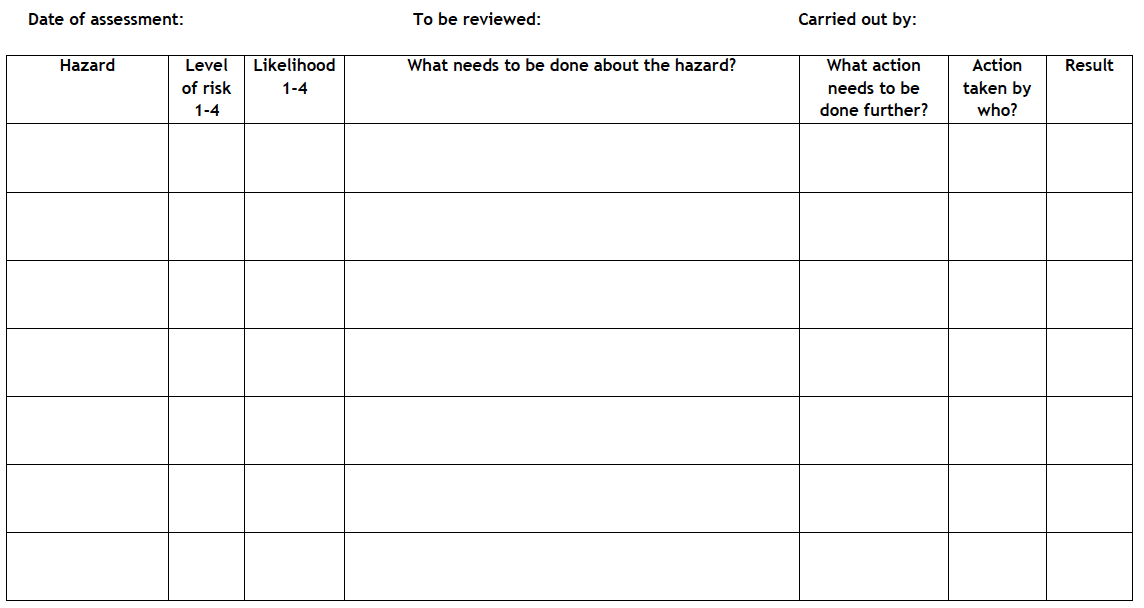
Sample - Play Ranger Risk Assessment Form
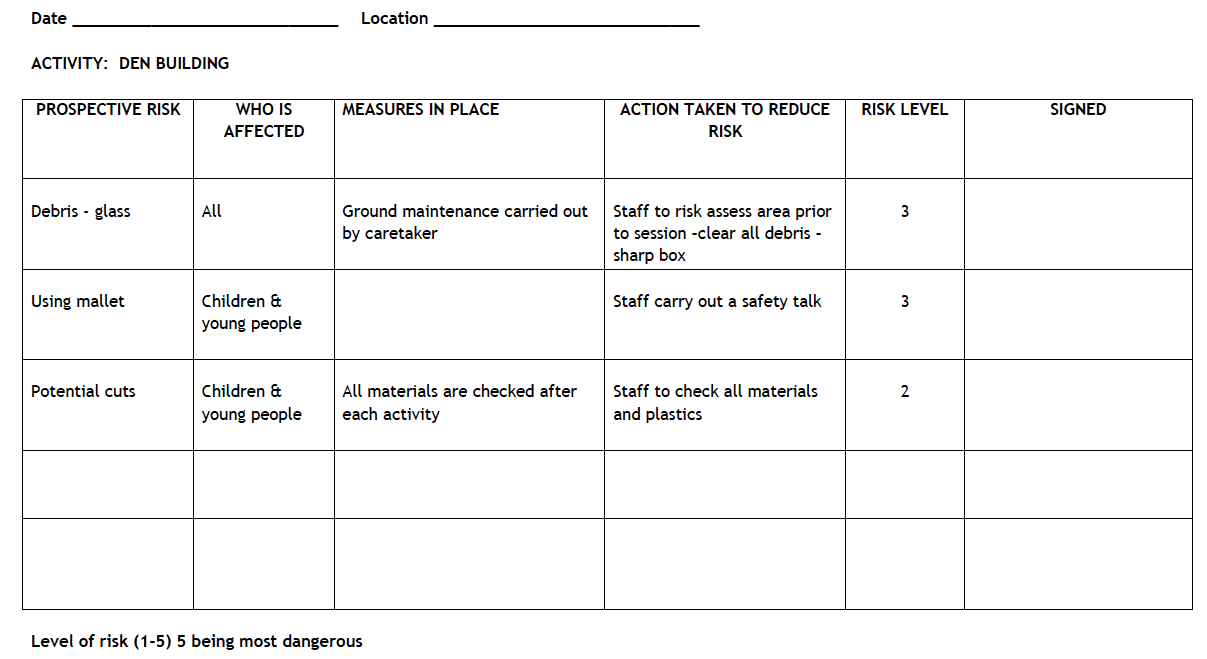
Sample Play Ranger Daily Hazard Check List
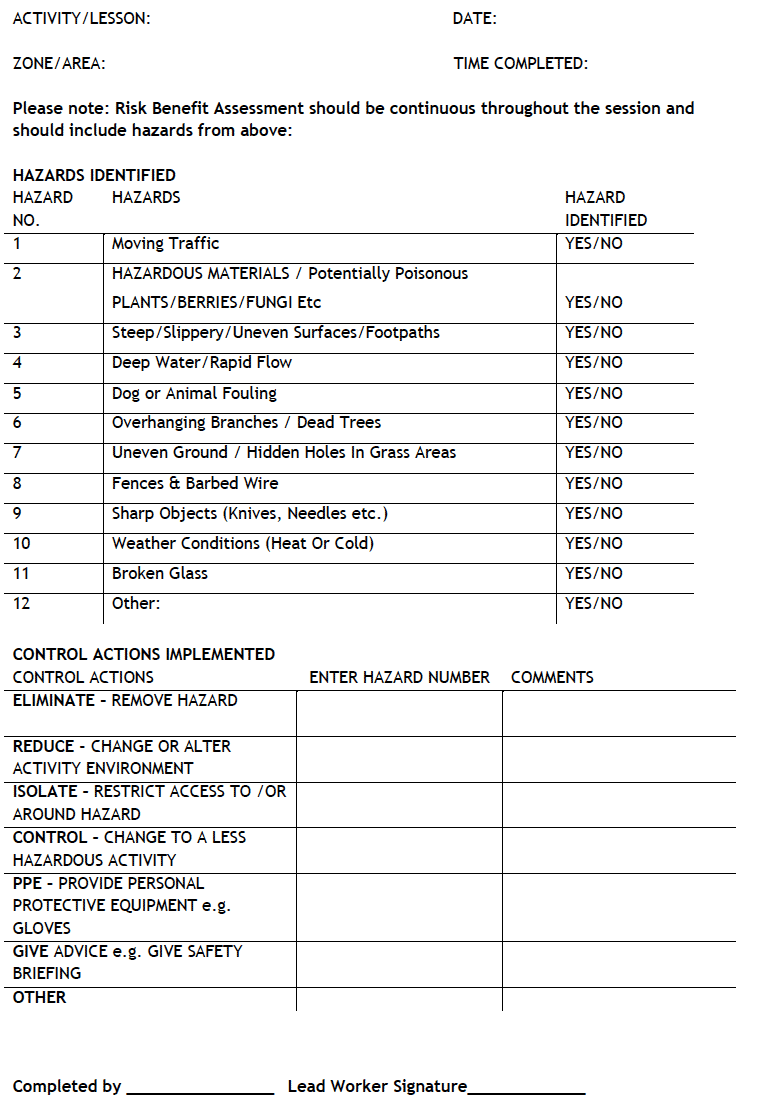
Sample - Needle and Syringe Disposal Guidelines
Consider training in this area if it is likely your staff will come across this situation and speak to your local Doctors / NHS regarding acquiring a Sharps Box.
1. Do not be alarmed
2. Remove children from the area
3. If possible disguise needle until you can get the correct container to remove it
4. Do not touch the sharp point with fingers or hand
5. Preferably use a litter picker to remove, put in the correct container (black needle box) which is at the back garage and seal it.
6. Put needle and syringe, point first into the container.
7. More than one can be placed in the black sharps box
8. If there are no correct containers for needles use a plastic tub with a lid and report this to your senior worker
9. Record this on the daily risk assessment sheet
10. Senior worker will report this to the necessary medical centre
Sample Incident Report
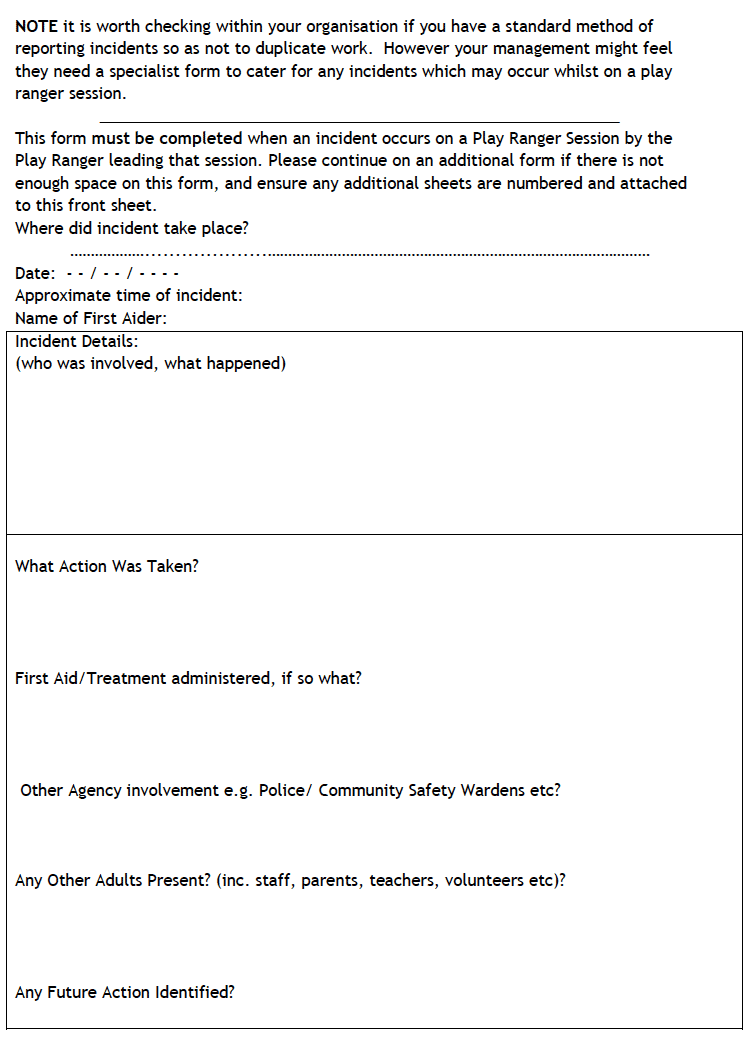
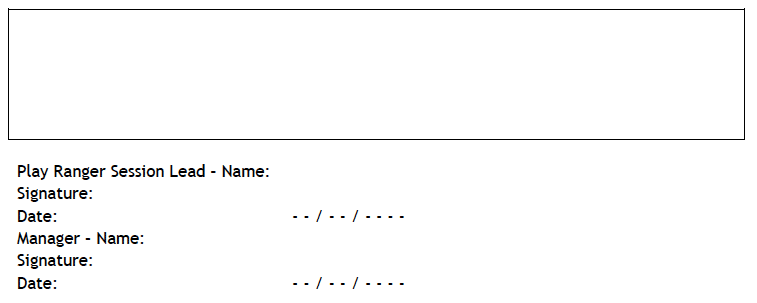
Contact
There is a problem
Thanks for your feedback